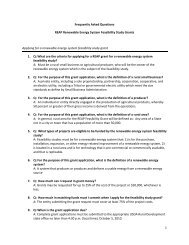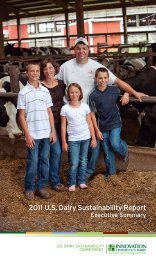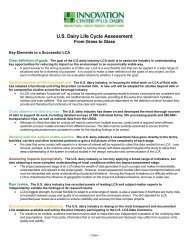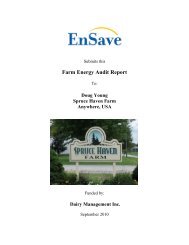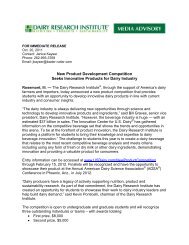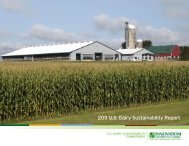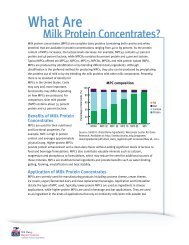Processor Handbook - Innovation Center for US Dairy
Processor Handbook - Innovation Center for US Dairy
Processor Handbook - Innovation Center for US Dairy
You also want an ePaper? Increase the reach of your titles
YUMPU automatically turns print PDFs into web optimized ePapers that Google loves.
Indirect energy: This is energy produced outside the<br />
company’s boundary that is consumed to supply energy<br />
<strong>for</strong> the organization’s intermediate energy needs (e.g.,<br />
electricity or heating and cooling). The most common<br />
example is fuel consumed outside the company’s boundary<br />
in order to generate electricity to be used inside the<br />
company’s boundary. (Definition from GRI G3.1 and updated<br />
to make relevant <strong>for</strong> processors and manufacturers)<br />
Intermediate energy: This includes <strong>for</strong>ms of energy that<br />
are produced by converting primary energy into other<br />
<strong>for</strong>ms. For most companies, electricity will be the only<br />
significant <strong>for</strong>m of intermediate energy. (Definition from<br />
GRI G3.1 and updated to make relevant <strong>for</strong> processors and<br />
manufacturers)<br />
Renewable energy sources: Energy sources capable of<br />
being replenished within a short time through ecological<br />
cycles (as opposed to resources such as minerals, metals,<br />
oil, gas, and coal that do not renew in short time periods).<br />
Such energy sources include the sun, wind, moving water,<br />
organic plant and waste material (biomass), and the earth’s<br />
heat (geothermal). (Definition from <strong>US</strong> EPA 2011)<br />
Energy intensity: Energy consumption per unit of product<br />
6. Documentation<br />
Energy use in<strong>for</strong>mation can be obtained by reviewing<br />
invoices, measured or calculated heat/fuel accounting,<br />
estimations, etc.<br />
Amounts of MMBTUs can be taken directly from invoices<br />
and delivery notes, or can be converted using energy units<br />
multiplied by conversion factors in the Calculation and<br />
Reporting section. (Definition from GRI G3.1 Guidelines<br />
and updated to make relevant <strong>for</strong> processors and<br />
manufacturers)<br />
For a dairy processing or manufacturing plant, annual dairy<br />
product production can be calculated from annual sales.<br />
7. Resources<br />
• <strong>Dairy</strong>Plant Smart TM . Available at<br />
www.<strong>US</strong><strong>Dairy</strong>.com/PlantSmart.<br />
• T. Vellinga, C. Opio, B. Henderson and S. Henning,<br />
with P. Gerber. 2010. Greenhouse Gas Emissions from<br />
the <strong>Dairy</strong> Sector A Life Cycle Assessment Food and<br />
Agriculture Organization of the United Nations, Rome.<br />
• U.S. Environmental Protection Agency (U.S. EPA).<br />
2011. ENERGY STAR Focus on Energy Efficiency<br />
in <strong>Dairy</strong> Processing, www.energystar.gov/index.<br />
cfmc=in_focus.bus_dairy_processing.<br />
• <strong>Dairy</strong> fluid milk processors and ice-cream<br />
manufacturers can use the U.S EPA ENERGY STAR ®<br />
Processing Plant Energy Per<strong>for</strong>mance Indicator Tool<br />
<strong>for</strong> fluid milk and ice create to calculate<br />
energy intensity.<br />
Why measure GHG emissions<br />
The dairy industry has committed to reducing its GHG<br />
emissions by 25 percent by 2020. In order to understand<br />
the industry’s progress toward its goal, emissions from<br />
dairy plants should be estimated and reported.<br />
Processing accounts <strong>for</strong> 2.50 lbs. CO 2 e of the 17.6 lbs. CO 2 e,<br />
per gallon of milk consumed in the U.S., which represents<br />
approximately 14 percent of the total. 17<br />
Measuring carbon footprints can support dairy companies<br />
in identifying ways to reduce their GHG emissions and other<br />
environmental sustainability goals, but in many cases will also<br />
strengthen the economic sustainability of processing facilities.<br />
Several practices that reduce GHG emissions, such as<br />
increasing energy efficiency, also provide cost savings<br />
to the processor. An evaluation of emissions can be used<br />
to assess the reputational risks of dairy companies’<br />
association with GHG emissions.<br />
As indicated in Figure 1 - Primary Sources <strong>for</strong> Greenhouse<br />
Gas Emissions in U.S. Fluid Milk (page 11), GHGs are emitted<br />
across all stages of the dairy supply chain. The indicators<br />
in this section focus on GHGs at the processor and<br />
manufacturer level.<br />
Scope of the indicators<br />
The GHG intensity indicator measures direct and indirect<br />
GHG emissions in line with Scope 1 and Scope 2 of the WRI/<br />
WBCSD GHG protocol. 18<br />
Scope 3 indirect GHG emissions are currently not covered<br />
by the indicator <strong>for</strong> fluid milk processors and dairy product<br />
manufacturers. The reporting of GHG intensity is the total<br />
(Scope 1 + Scope 2) GHG emissions per unit of output.<br />
The indicators should be used to measure and report at the<br />
company level, aggregating the totals from facilitates.<br />
Companies should explain if all facilities are included in<br />
the indicators. They can use Plant Smart to calculate the<br />
greenhouse gas intensity indicator.<br />
GHG Intensity —<br />
Primary PM GHG<br />
Relevant Plant Smart Tabs<br />
Transport<br />
Energy<br />
Refrigerant<br />
Packaging<br />
Greenhouse Gas<br />
4<br />
continued on page 30<br />
29





